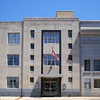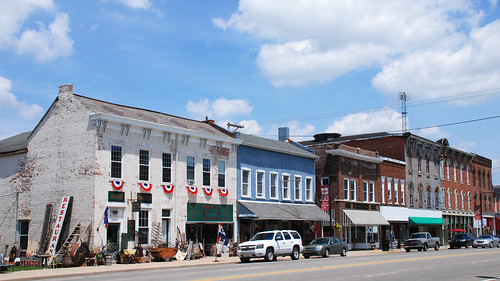 One Click...
One Click...
to all things local!
Architecture
With a wealth of styles from pioneer built log cabins to Art Moderne, and everything in between, Wayne County is an architecture lover's dream. Explore the wide variety of excellent reference materials listed below (most available at area libraries) and become a building watcher. Try to determine the style of your favorite buildings - but don't be surprised if many are a mixture of several styles!
Architectural Styles
Federal (1810-1845)
 Flat, undecorated wall surfaces of local materials, usually brick or wood weatherboard. Low-pitched gable roof. End chimneys. Large, multi-paned windows. Fanlight and narrow sidelights at entrance. Most common
along navigable waterways and early transportation routes such as the National Road.
Flat, undecorated wall surfaces of local materials, usually brick or wood weatherboard. Low-pitched gable roof. End chimneys. Large, multi-paned windows. Fanlight and narrow sidelights at entrance. Most common
along navigable waterways and early transportation routes such as the National Road.
Greek Revival (1840-1860)
 Inspired by classical Greek temple forms, with a heavy cornice and Doric, Ionic or Corinthian columns and pilasters. Customarily of smooth-faced stone, brick or wood. Sidelights and transom at entrance. Popular for courthouses and churches as well as houses.
Inspired by classical Greek temple forms, with a heavy cornice and Doric, Ionic or Corinthian columns and pilasters. Customarily of smooth-faced stone, brick or wood. Sidelights and transom at entrance. Popular for courthouses and churches as well as houses.
Gothic Revival (1850-1870)
 Emphasis on verticality, typified by steeply pitched roof, pointed arches, and vertical board-and-batten siding. Straight-headed and hooded openings. Bargeboard trim at gable. Later examples distinguished by enriched wall surfaces created through the use of materials of contrasting color and texture. Though Gothic Revival ceased to be favored as a style for houses by the 1870s, it remained popular as a
style for religious architecture well into the twentieth century.
Emphasis on verticality, typified by steeply pitched roof, pointed arches, and vertical board-and-batten siding. Straight-headed and hooded openings. Bargeboard trim at gable. Later examples distinguished by enriched wall surfaces created through the use of materials of contrasting color and texture. Though Gothic Revival ceased to be favored as a style for houses by the 1870s, it remained popular as a
style for religious architecture well into the twentieth century.
Italianate (1855-1890)
 Predominant style in Indiana during the late nineteenth century, loosely derived from Italian villas. Vertical composition. Tall, narrow, slightly arched windows with segmental or round arched hoods. Low-pitched
hipped roof supported by decorative brackets and often topped with a cupola.
Predominant style in Indiana during the late nineteenth century, loosely derived from Italian villas. Vertical composition. Tall, narrow, slightly arched windows with segmental or round arched hoods. Low-pitched
hipped roof supported by decorative brackets and often topped with a cupola.
Second Empire (1860-1885)
 Americanization of nineteenth-century French Renaissance Revival style popularized in Paris during the reign of Napoleon III. Typified by mansard roof, usually of slate, with elaborate brackets and projecting dormers. Polychromatic ornamentation. Often features central pavilion or tower
Americanization of nineteenth-century French Renaissance Revival style popularized in Paris during the reign of Napoleon III. Typified by mansard roof, usually of slate, with elaborate brackets and projecting dormers. Polychromatic ornamentation. Often features central pavilion or tower
Romanesque Revival (1880-1900)
 Adapted from European medieval architecture. Massive scale. Rock-faced stone exterior relieved by trim of contrasting color or texture. Short, grouped columns support thick, round arches. Windows of varied size and shape. Steeply pitched roof. Towers and turrets common. Most often used for large public buildings.
Adapted from European medieval architecture. Massive scale. Rock-faced stone exterior relieved by trim of contrasting color or texture. Short, grouped columns support thick, round arches. Windows of varied size and shape. Steeply pitched roof. Towers and turrets common. Most often used for large public buildings.
Queen Anne (1885-1905)
 Combines medieval and classical elements to create the most exuberant of nineteenth-century styles. Asymmetrical composition, with towers, turrets, tall chimneys, bay windows, projecting pavilions, spindled porches and balconies. Contrasting materials on wall surfaces. Stained glass windows.
Combines medieval and classical elements to create the most exuberant of nineteenth-century styles. Asymmetrical composition, with towers, turrets, tall chimneys, bay windows, projecting pavilions, spindled porches and balconies. Contrasting materials on wall surfaces. Stained glass windows.
Vernacular Victorian (1870-1910)
Simplified house form with T, L or rectangular plan, embellished with details derived from late-nineteenth century styles, usually Queen Anne or Italianate. Also used for commercial buildings of modest size. Most detailing is manufactured wood elements applied at cornice and on porch, such as gingerbread trim in gable, spindled friezes and turned porch posts.
Neoclassical (1895-1930)
 Originated by the Ecole des Beaux Arts in Paris, in the U.S. the style became popular for large buildings after the 1893 Columbian Exposition in Chicago. Bold and symmetrical in form and lavish in detail, sometimes embellished with sculpture. Elaborate GrecoRoman classical details such as freestanding columns, heavy moldings, pediments, and balustrades applied to facade. Favored as style for banks, libraries and courthouses.
Originated by the Ecole des Beaux Arts in Paris, in the U.S. the style became popular for large buildings after the 1893 Columbian Exposition in Chicago. Bold and symmetrical in form and lavish in detail, sometimes embellished with sculpture. Elaborate GrecoRoman classical details such as freestanding columns, heavy moldings, pediments, and balustrades applied to facade. Favored as style for banks, libraries and courthouses.
Colonial Revival (1890-1940)
 A revival of eighteenth-century colonial architecture and one of many revival styles popular in the early twentieth century. Symmetrical massing. Commonly used details include Palladian windows, quoins, garlands, heavy dentils, pedimented dormers, classical columns or pilasters. Multipaned windows with shutters. Entrance with fanlight and sidelights.
A revival of eighteenth-century colonial architecture and one of many revival styles popular in the early twentieth century. Symmetrical massing. Commonly used details include Palladian windows, quoins, garlands, heavy dentils, pedimented dormers, classical columns or pilasters. Multipaned windows with shutters. Entrance with fanlight and sidelights.
Tudor Revival (1900-1940)
 Revival style modeled on English manor houses and cottages. Light stucco wall surfaces and dark half-timbering. Steeply pitched slate roof with prominent gables. Leaded glass windows, often with diamond-shaped panes. Tudor-arched entrance. Usually built of brick or stone and stucco.
Revival style modeled on English manor houses and cottages. Light stucco wall surfaces and dark half-timbering. Steeply pitched slate roof with prominent gables. Leaded glass windows, often with diamond-shaped panes. Tudor-arched entrance. Usually built of brick or stone and stucco.
Prairie (1900-1920)
Originated by a group of Chicago architects, including Frank Lloyd Wright, the style's most famous proponent. Marked by horizontal, ground-hugging quality, with low-pitched hipped roof, widely overhanging eaves, and horizontal bands of windows. Two-story central portion flanked by low, one-story wings or porches. Usually built of brick or stucco and wood.
American Four Square (1900-1930)
 Square or rectangular house plan with two full stories, imparting box-like appearance. Large attic under hipped roof, usually with hip-roof dormers and wide, projecting eaves. Balanced and plain facade of brick, clapboard or stucco. Windows often arranged in pairs, with multi-paned upper sashes. One-story porch spans front facade
Square or rectangular house plan with two full stories, imparting box-like appearance. Large attic under hipped roof, usually with hip-roof dormers and wide, projecting eaves. Balanced and plain facade of brick, clapboard or stucco. Windows often arranged in pairs, with multi-paned upper sashes. One-story porch spans front facade
Bungalow (1905-1940)
 One or one-and-a-half story house. Lowpitched roof with widely overhanging eaves and prominent dormer. Full or partial front porch. Roof rafters usually exposed, embellished by straight brackets or knee braces. Prominent chimneys and porch piers of field stone, rubble or rough-faced brick.
One or one-and-a-half story house. Lowpitched roof with widely overhanging eaves and prominent dormer. Full or partial front porch. Roof rafters usually exposed, embellished by straight brackets or knee braces. Prominent chimneys and porch piers of field stone, rubble or rough-faced brick.
Art Deco/Art Moderne (1925-1940)
 Art Deco characterized by bold geometric form and stylized decoration often of Egyptian influence. Low-relief ornamentation, often in form of zigzags, chevrons and/or volutes executed in colored glazed bricks, terra cotta, mosaic tiles or metal panels. Casement or metal sash windows often arranged in vertical strips. Art Moderne applies streamlined and aerodynamic compositions used by industrial designers to convey newness and speed. Often used in residential buildings. Characterized by horizontal bands, portal windows, glass block, flat roofs
Art Deco characterized by bold geometric form and stylized decoration often of Egyptian influence. Low-relief ornamentation, often in form of zigzags, chevrons and/or volutes executed in colored glazed bricks, terra cotta, mosaic tiles or metal panels. Casement or metal sash windows often arranged in vertical strips. Art Moderne applies streamlined and aerodynamic compositions used by industrial designers to convey newness and speed. Often used in residential buildings. Characterized by horizontal bands, portal windows, glass block, flat roofs
Historic American Buildings Survey
Historic buildings in Wayne County, Indiana, highlighted on the Library of Congress' American Memory "Built in America" website.
- Benjamin Conklin House, 302 East Main Street, Cambridge City, Wayne County, Indiana
- Coffee Pot Restaurant, U.S. Route 40, Pennville, Wayne County, IN
- Huddleston House, East Main Street (U.S. Route 40), Mount Auburn, Wayne County, IN
- Vinton House Inn, National Road (U.S. Route 40) Cambridge City, Wayne County, Indiana
- Jacob Julian House, 313 West Main Street, Centerville, Wayne County, IN
- Lantz House, 214 West Main Street, Centerville, Wayne County, IN
- Mansion House, 214 East Main Street, Centerville, Wayne County, IN
- Levi Coffin House, Main Cross & Mill Streets, Fountain City, Wayne County, IN
- Daniels House, State Route 1, Milton, Wayne County, IN
- Daniels House, Outbuilding, State Route 1, Milton, Wayne County, IN
- Justice House, 109 Seminary Street, Milton, Wayne County, IN
- Isaac Kinsey House & Farm, 502 East Sarver Road, Milton, Wayne County, IN - Beechwood
- Wayne County Bridge No. 122, Spanning West Fork Whitewater River at Main Street, Milton, Wayne County, IN
- Adams House, Liberty Avenue, Richmond, Wayne, IN
- Andrew Scott House, 126 North Tenth Street, Richmond, Wayne, IN
- Bethel African Methodist Episcopal Church, 200 Sixth Street, Richmond, Wayne, IN
- City Market House, South Sixth & A Streets, Richmond, Wayne, IN
- Earlham College Observatory, National Road, Richmond, Wayne, IN
- Hicksite Friends Meetinghouse, 1150 North A Street, Richmond, Wayne, IN
- Main Street Bridge, Spanning East Fork Whitewater River, Richmond, Wayne, IN
- Raukopf House, 240 South Third Street, Richmond, Wayne, IN
- Starr Historic District, 203-205 North Eleventh Street (House), Richmond, Wayne, IN
- Starr Historic District, 207 Thirteenth Street (House), Richmond, Wayne, IN
- Starr Historic District, 210 North Eleventh Street (House), Richmond, Wayne, IN
- Starr Historic District, 215 North Eleventh Street (House), Richmond, Wayne, IN
- Starr Historic District, 222 North Tenth Street (House), 222 North Tenth Street, Richmond, Wayne, IN
- Starr Historic District, 224 North Twelfth Street (House), Richmond, Wayne, IN
- Starr Historic District, 227 Thirteenth Street (House), Richmond, Wayne, IN
- Starr Historic District, 302 North Twelfth Street, 302 North Twelfth Street, Richmond, Wayne, IN
- Starr Historic District, 312 North Twelfth Street (House), Richmond, Wayne, IN
- Starr Historic District, 322 North Twelfth Street (House), Richmond, Wayne, IN
- Starr Historic District, Elizabeth Starr House, 326 North Tenth Street, Richmond, Wayne, IN
- Starr Historic District, Knights of Columbus Building, 204 North Tenth Street, Richmond, Wayne, IN
- Starr Historic District, Lynde House, 308 North Twelfth Street, Richmond, Wayne, IN
- Starr Historic District, Richmond, Wayne, IN
- Starr Piano Factory & Richmond Gas Company, G Street Bridge & Main Street Bridge, Richmond, Wayne, IN
- Thomas Harrison House, 514 West Main Street, Richmond, Wayne, IN
- Wayne County Courthouse, Courthouse Square, Richmond, Wayne, IN
- Workers' Cottages, Bound by South Second, Eleventh, A, & E Streets, Richmond, Wayne, IN
Cambridge City
Centerville
Fountain City
Milton
Richmond
Reference
Books & Bibliographies
Greek Revival Houses 1834-1859
Richmond, Indiana: A pictorial history
Richmond Indiana: Its Physical Development and Aesthetic Heritage to 1920
Wayne County, Indiana Interim Report 2001: Historic Sites and Structures Inventory
Databases
Historic Architecture Survey Database - Richmond
State Historic Architectural and Archaeological Research Database (SHAARD)
Architectural Styles
Indiana DNR: Architectural Styles
Preservation Groups & Resources
Richmond Columbian Properties, Inc.
Text for Architectural Styles taken from "On the Street Where You Live", published by Indiana Landmarks.
![]()
![]()
![]()
![]()
|
This jQuery slider was created with the free EasyRotator software from DWUser.com.
Need a powerful Flash slideshow creator with built-in iPhone/iPad/Android support? EasyRotator is supported by the XML Flash Slideshow v4 Software. OK |
This jQuery slider was created with the free EasyRotator software from DWUser.com.
Need a powerful Flash slideshow creator with built-in iPhone/iPad/Android support? EasyRotator is supported by the XML Flash Slideshow v4 Software. OK |
|
This jQuery slider was created with the free EasyRotator software from DWUser.com.
Use WordPress? The free EasyRotator for WordPress plugin lets you create beautiful WordPress sliders in seconds. OK |
This jQuery slider was created with the free EasyRotator software from DWUser.com.
Use WordPress? The free EasyRotator for WordPress plugin lets you create beautiful WordPress sliders in seconds. OK |
Featured Member
Community Photo
More Photos:
Wayne County | WayNet Albums
Did You Know?
Wayne County Fast Facts
| Location: | East Central Indiana, USA |
| Founded: | 1810 |
| Population: | 66,456 |
| Elevation: | 1,257 feet Highest Point in Indiana |
| County Seat: | Richmond |
| Local Time: | |
| Date: | |
| About Indiana: | IN.gov |
| Current Weather: |
Follow Us
Contact Us
| Email: | info@waynet.org |
| Phone: | 765.939.0857 |
| Mail: | 50 North 5th St. Richmond, IN 47374 |
| Director: | Board of Directors |
Stay in Touch
Sign up for WayNet News
- our e-newsletter.
Translate This Page
Join WayNet
About WayNet
Waynet, Inc. is a non-profit, 501(c)4 corporation that is fully-funded through memberships. Please support our members and let them know you located them via WayNet.org.
Top 25: popular pages & circulation information.
Our Recent Tweets
Copyright © Waynet, Inc. 2022, All Rights Reserved.| Policies
Directory | News | Discover | Find It Fast | Knowledge | To Do | Members


























